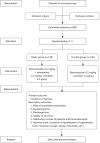Effects of non-intubation anesthesia based on a fentanyl-reduced regimen on hypoxemia during bronchoscopy for older patients: study protocol for a randomized controlled trial
- PMID: 40809265
- PMCID: PMC12340278
- DOI: 10.21037/jtd-2025-475
Effects of non-intubation anesthesia based on a fentanyl-reduced regimen on hypoxemia during bronchoscopy for older patients: study protocol for a randomized controlled trial
Abstract
Background: Older patients are more likely to suffer from cardiopulmonary events during sedation-based bronchoscopy. It is important to balance the inhibition of stress and cardiopulmonary function, particularly for the elderly. This randomized controlled trial aims to investigate a fentanyl-reduced regimen on hypoxemia during bronchoscopy for older patients.
Methods: Eligible patients will be randomly allocated to the study group or control group. Medication regimen for the study group is remimazolam 0.2 mg/kg + esketamine 0.3 mg/kg + fentanyl 0.5 µg/kg, whereas those in the control group will receive remimazolam 0.2 mg/kg + fentanyl 1.5 µg/kg. Remimazolam 0.05 mg/kg will serve as top-ups for both groups. The primary outcome is the incidence of hypoxemia during bronchoscopy. The secondary outcomes include rates of successful examination, awakening time, discharge time, quality of recovery, satisfactory scores of patients and the endoscopist, incidences of hypotension or hypertension and body movement (cough, swing of the limbs, etc.).
Discussion: The present study aims to assess the effects of a fentanyl-reduced protocol on bronchoscopy for older patients. The results are supposed to be that the fentanyl-reduced regimen can provide sufficient sedation for geriatric bronchoscopy with fewer adverse events, which is worthy of clinical adoption.
Trial registration: The trial has been registered at Chinese Clinical Trial Registry (ChiCTR2400084672).
Keywords: Esketamine; bronchoscopy; hypoxia; older patients; remimazolam.
Copyright © 2025 AME Publishing Company. All rights reserved.
Conflict of interest statement
Conflicts of Interest: All authors have completed the ICMJE uniform disclosure form (available at https://jtd.amegroups.com/article/view/10.21037/jtd-2025-475/coif). The authors have no conflicts of interest to declare.
Similar articles
-
Prescription of Controlled Substances: Benefits and Risks.2025 Jul 6. In: StatPearls [Internet]. Treasure Island (FL): StatPearls Publishing; 2025 Jan–. 2025 Jul 6. In: StatPearls [Internet]. Treasure Island (FL): StatPearls Publishing; 2025 Jan–. PMID: 30726003 Free Books & Documents.
-
Low-dose esketamine combined with propofol versus fentanyl-propofol for preventing hypoxemia during gastroscopy sedation in high-altitude residents: a randomized controlled trial.BMC Anesthesiol. 2025 Jul 30;25(1):383. doi: 10.1186/s12871-025-03280-y. BMC Anesthesiol. 2025. PMID: 40739541 Free PMC article. Clinical Trial.
-
Efficacy and safety of remimazolam combined with remifentanil for sedation during awake fiberoptic intubation: a randomized controlled trial.Ann Med. 2025 Dec;57(1):2527951. doi: 10.1080/07853890.2025.2527951. Epub 2025 Jul 3. Ann Med. 2025. PMID: 40605581 Free PMC article. Clinical Trial.
-
The Black Book of Psychotropic Dosing and Monitoring.Psychopharmacol Bull. 2024 Jul 8;54(3):8-59. Psychopharmacol Bull. 2024. PMID: 38993656 Free PMC article. Review.
-
Corticosteroids for the treatment of Duchenne muscular dystrophy.Cochrane Database Syst Rev. 2016 May 5;2016(5):CD003725. doi: 10.1002/14651858.CD003725.pub4. Cochrane Database Syst Rev. 2016. PMID: 27149418 Free PMC article.
References
-
- Marchioni A, Andrisani D, Tonelli R, et al. Integrated intErventional bronchoscopy in the treatment of locally adVanced non-small lung cancER with central Malignant airway Obstructions: a multicentric REtrospective study (EVERMORE). Lung Cancer 2020;148:40-7. 10.1016/j.lungcan.2020.07.032 - DOI - PubMed
LinkOut - more resources
Full Text Sources

